Comprehensive Care Plan: Post-operative Wound Dehiscence - 2803NRS
VerifiedAdded on 2022/12/23
|8
|2251
|1
Essay
AI Summary
This essay examines post-operative wound dehiscence, a significant complication following surgery, particularly in cases like total knee arthroplasty. It begins by defining wound dehiscence and outlining associated risk factors, including intraoperative considerations, patient-specific vulnerabilities like age, obesity, and diabetes, and the impact of factors such as poor nutrition and smoking. The essay then delves into the pathophysiology of wound dehiscence. The case study of John Grant is used to illustrate the concepts. Two critical components of initial post-operative assessment are discussed: pain assessment, utilizing rating scales to gauge the patient's experience, and infection examination, considering the increased risk in patients with conditions like diabetes. The nursing priorities for John Grant are identified as post-operative wound dehiscence and diabetes management. The essay then presents a comprehensive nursing care plan, encompassing assessment of the wound and systemic conditions, goal setting to reduce pain and prevent infection, implementation of interventions such as wound cleansing, appropriate dressings, patient education, and medication management, and evaluation of outcomes. The essay reflects on the chosen health concern, highlighting the challenges of wound healing in older patients with reduced immunity and the importance of a structured care plan. The essay also mentions other conditions that require ongoing management, such as hyperlipidaemia and gastro-oesophageal reflux disease. The essay concludes by emphasizing the application of a comprehensive plan for the chosen concern.
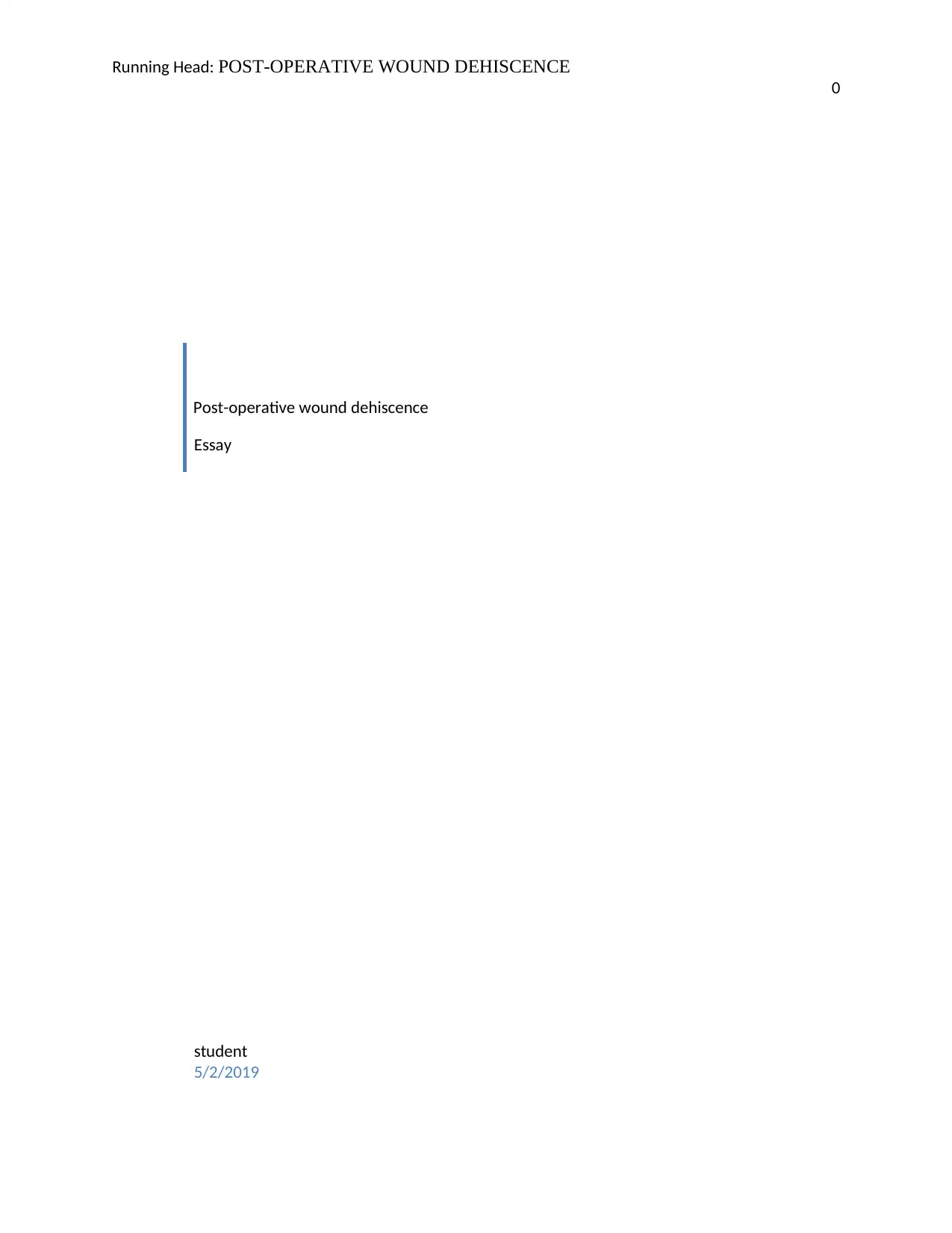
Running Head: POST-OPERATIVE WOUND DEHISCENCE
0
Post-operative wound dehiscence
Essay
student
5/2/2019
0
Post-operative wound dehiscence
Essay
student
5/2/2019
Paraphrase This Document
Need a fresh take? Get an instant paraphrase of this document with our AI Paraphraser
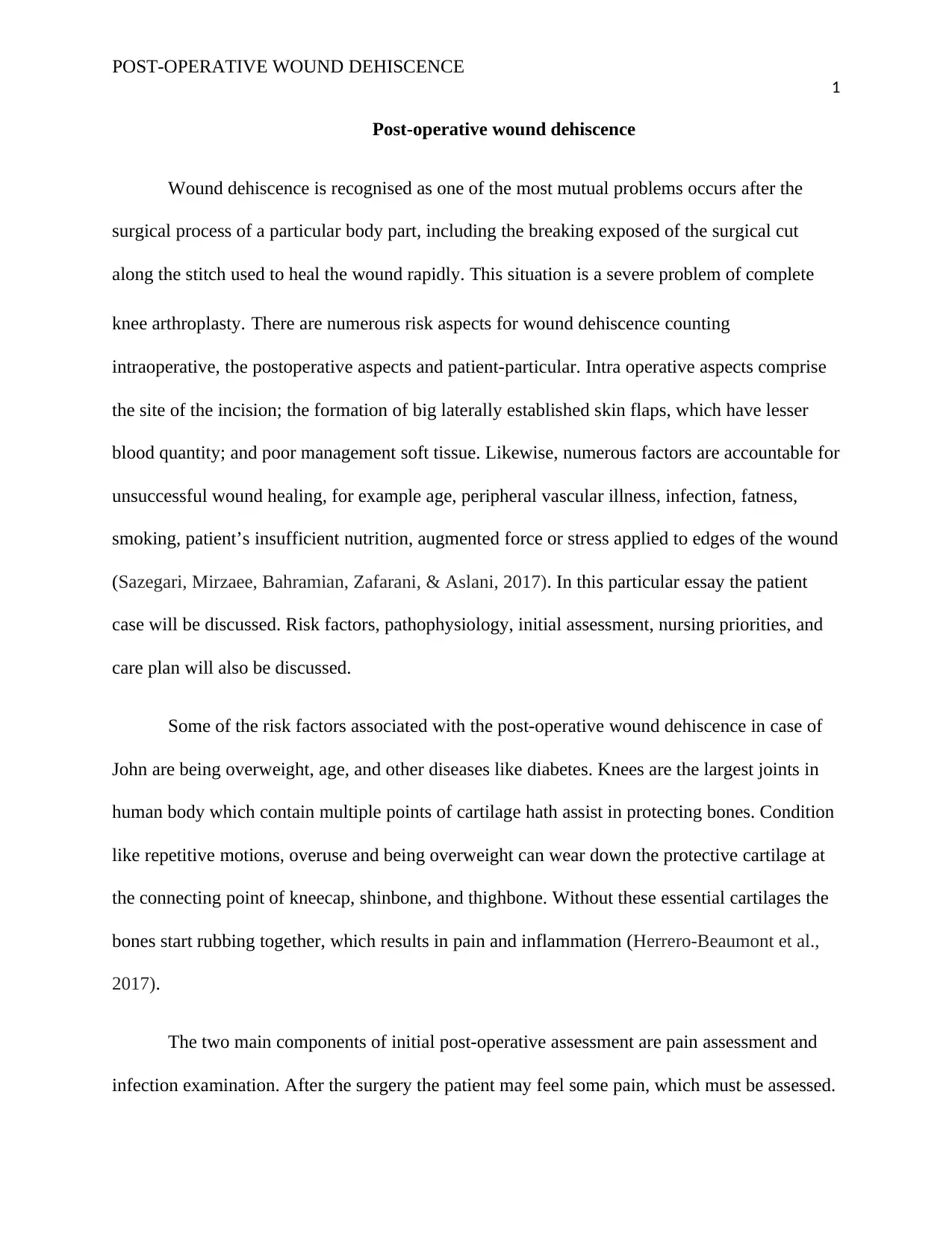
POST-OPERATIVE WOUND DEHISCENCE
1
Post-operative wound dehiscence
Wound dehiscence is recognised as one of the most mutual problems occurs after the
surgical process of a particular body part, including the breaking exposed of the surgical cut
along the stitch used to heal the wound rapidly. This situation is a severe problem of complete
knee arthroplasty. There are numerous risk aspects for wound dehiscence counting
intraoperative, the postoperative aspects and patient-particular. Intra operative aspects comprise
the site of the incision; the formation of big laterally established skin flaps, which have lesser
blood quantity; and poor management soft tissue. Likewise, numerous factors are accountable for
unsuccessful wound healing, for example age, peripheral vascular illness, infection, fatness,
smoking, patient’s insufficient nutrition, augmented force or stress applied to edges of the wound
(Sazegari, Mirzaee, Bahramian, Zafarani, & Aslani, 2017). In this particular essay the patient
case will be discussed. Risk factors, pathophysiology, initial assessment, nursing priorities, and
care plan will also be discussed.
Some of the risk factors associated with the post-operative wound dehiscence in case of
John are being overweight, age, and other diseases like diabetes. Knees are the largest joints in
human body which contain multiple points of cartilage hath assist in protecting bones. Condition
like repetitive motions, overuse and being overweight can wear down the protective cartilage at
the connecting point of kneecap, shinbone, and thighbone. Without these essential cartilages the
bones start rubbing together, which results in pain and inflammation (Herrero-Beaumont et al.,
2017).
The two main components of initial post-operative assessment are pain assessment and
infection examination. After the surgery the patient may feel some pain, which must be assessed.
1
Post-operative wound dehiscence
Wound dehiscence is recognised as one of the most mutual problems occurs after the
surgical process of a particular body part, including the breaking exposed of the surgical cut
along the stitch used to heal the wound rapidly. This situation is a severe problem of complete
knee arthroplasty. There are numerous risk aspects for wound dehiscence counting
intraoperative, the postoperative aspects and patient-particular. Intra operative aspects comprise
the site of the incision; the formation of big laterally established skin flaps, which have lesser
blood quantity; and poor management soft tissue. Likewise, numerous factors are accountable for
unsuccessful wound healing, for example age, peripheral vascular illness, infection, fatness,
smoking, patient’s insufficient nutrition, augmented force or stress applied to edges of the wound
(Sazegari, Mirzaee, Bahramian, Zafarani, & Aslani, 2017). In this particular essay the patient
case will be discussed. Risk factors, pathophysiology, initial assessment, nursing priorities, and
care plan will also be discussed.
Some of the risk factors associated with the post-operative wound dehiscence in case of
John are being overweight, age, and other diseases like diabetes. Knees are the largest joints in
human body which contain multiple points of cartilage hath assist in protecting bones. Condition
like repetitive motions, overuse and being overweight can wear down the protective cartilage at
the connecting point of kneecap, shinbone, and thighbone. Without these essential cartilages the
bones start rubbing together, which results in pain and inflammation (Herrero-Beaumont et al.,
2017).
The two main components of initial post-operative assessment are pain assessment and
infection examination. After the surgery the patient may feel some pain, which must be assessed.
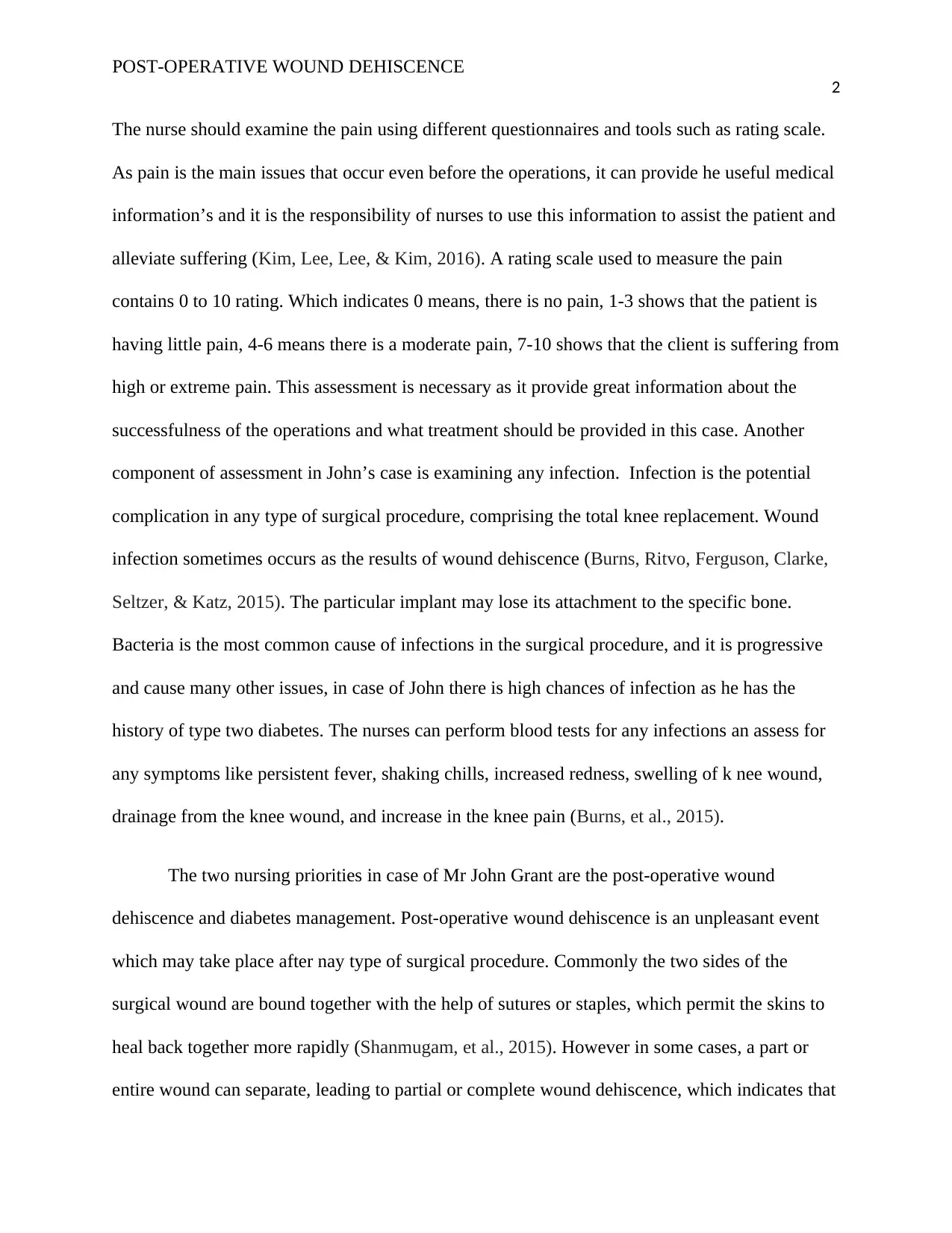
POST-OPERATIVE WOUND DEHISCENCE
2
The nurse should examine the pain using different questionnaires and tools such as rating scale.
As pain is the main issues that occur even before the operations, it can provide he useful medical
information’s and it is the responsibility of nurses to use this information to assist the patient and
alleviate suffering (Kim, Lee, Lee, & Kim, 2016). A rating scale used to measure the pain
contains 0 to 10 rating. Which indicates 0 means, there is no pain, 1-3 shows that the patient is
having little pain, 4-6 means there is a moderate pain, 7-10 shows that the client is suffering from
high or extreme pain. This assessment is necessary as it provide great information about the
successfulness of the operations and what treatment should be provided in this case. Another
component of assessment in John’s case is examining any infection. Infection is the potential
complication in any type of surgical procedure, comprising the total knee replacement. Wound
infection sometimes occurs as the results of wound dehiscence (Burns, Ritvo, Ferguson, Clarke,
Seltzer, & Katz, 2015). The particular implant may lose its attachment to the specific bone.
Bacteria is the most common cause of infections in the surgical procedure, and it is progressive
and cause many other issues, in case of John there is high chances of infection as he has the
history of type two diabetes. The nurses can perform blood tests for any infections an assess for
any symptoms like persistent fever, shaking chills, increased redness, swelling of k nee wound,
drainage from the knee wound, and increase in the knee pain (Burns, et al., 2015).
The two nursing priorities in case of Mr John Grant are the post-operative wound
dehiscence and diabetes management. Post-operative wound dehiscence is an unpleasant event
which may take place after nay type of surgical procedure. Commonly the two sides of the
surgical wound are bound together with the help of sutures or staples, which permit the skins to
heal back together more rapidly (Shanmugam, et al., 2015). However in some cases, a part or
entire wound can separate, leading to partial or complete wound dehiscence, which indicates that
2
The nurse should examine the pain using different questionnaires and tools such as rating scale.
As pain is the main issues that occur even before the operations, it can provide he useful medical
information’s and it is the responsibility of nurses to use this information to assist the patient and
alleviate suffering (Kim, Lee, Lee, & Kim, 2016). A rating scale used to measure the pain
contains 0 to 10 rating. Which indicates 0 means, there is no pain, 1-3 shows that the patient is
having little pain, 4-6 means there is a moderate pain, 7-10 shows that the client is suffering from
high or extreme pain. This assessment is necessary as it provide great information about the
successfulness of the operations and what treatment should be provided in this case. Another
component of assessment in John’s case is examining any infection. Infection is the potential
complication in any type of surgical procedure, comprising the total knee replacement. Wound
infection sometimes occurs as the results of wound dehiscence (Burns, Ritvo, Ferguson, Clarke,
Seltzer, & Katz, 2015). The particular implant may lose its attachment to the specific bone.
Bacteria is the most common cause of infections in the surgical procedure, and it is progressive
and cause many other issues, in case of John there is high chances of infection as he has the
history of type two diabetes. The nurses can perform blood tests for any infections an assess for
any symptoms like persistent fever, shaking chills, increased redness, swelling of k nee wound,
drainage from the knee wound, and increase in the knee pain (Burns, et al., 2015).
The two nursing priorities in case of Mr John Grant are the post-operative wound
dehiscence and diabetes management. Post-operative wound dehiscence is an unpleasant event
which may take place after nay type of surgical procedure. Commonly the two sides of the
surgical wound are bound together with the help of sutures or staples, which permit the skins to
heal back together more rapidly (Shanmugam, et al., 2015). However in some cases, a part or
entire wound can separate, leading to partial or complete wound dehiscence, which indicates that
⊘ This is a preview!⊘
Do you want full access?
Subscribe today to unlock all pages.

Trusted by 1+ million students worldwide
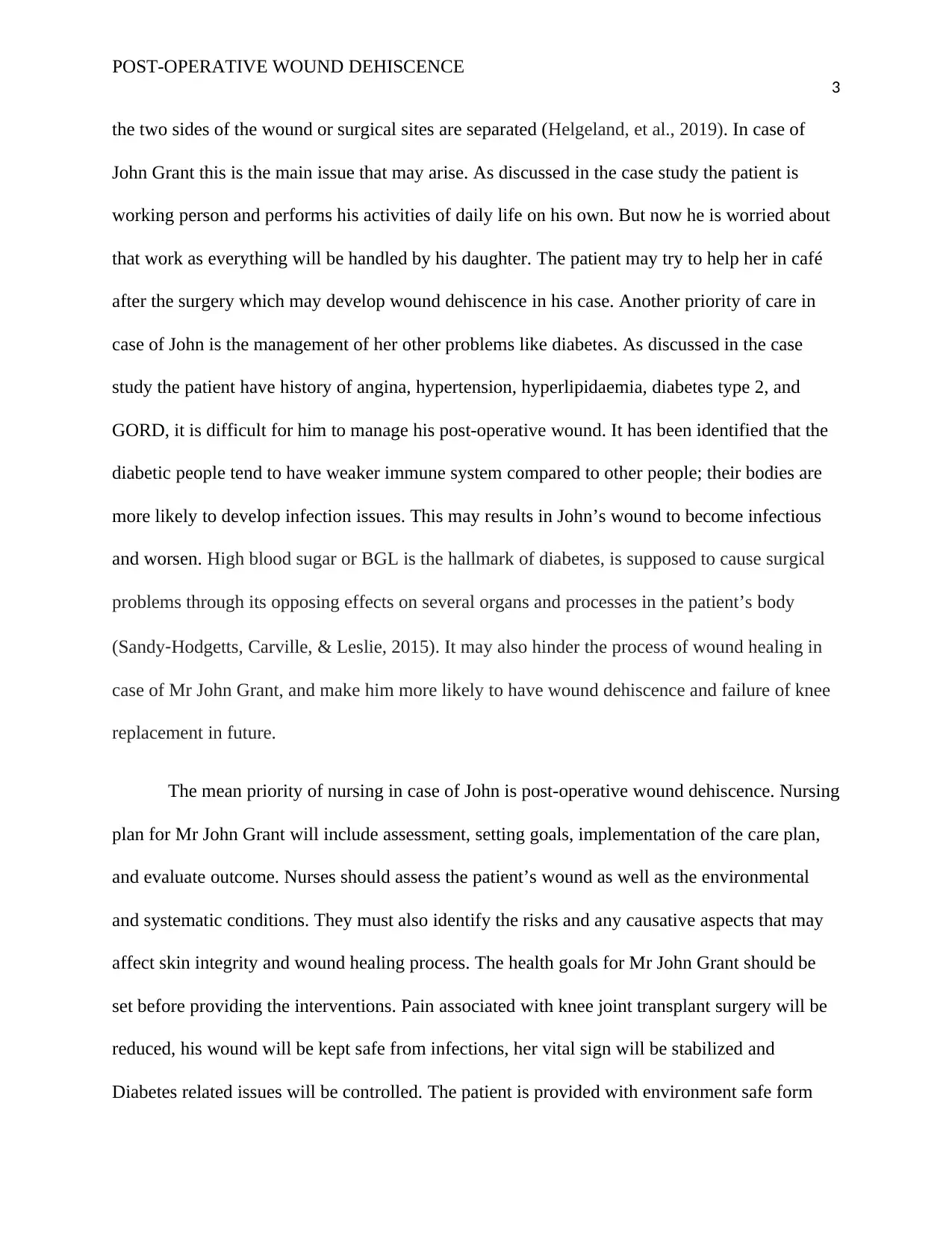
POST-OPERATIVE WOUND DEHISCENCE
3
the two sides of the wound or surgical sites are separated (Helgeland, et al., 2019). In case of
John Grant this is the main issue that may arise. As discussed in the case study the patient is
working person and performs his activities of daily life on his own. But now he is worried about
that work as everything will be handled by his daughter. The patient may try to help her in café
after the surgery which may develop wound dehiscence in his case. Another priority of care in
case of John is the management of her other problems like diabetes. As discussed in the case
study the patient have history of angina, hypertension, hyperlipidaemia, diabetes type 2, and
GORD, it is difficult for him to manage his post-operative wound. It has been identified that the
diabetic people tend to have weaker immune system compared to other people; their bodies are
more likely to develop infection issues. This may results in John’s wound to become infectious
and worsen. High blood sugar or BGL is the hallmark of diabetes, is supposed to cause surgical
problems through its opposing effects on several organs and processes in the patient’s body
(Sandy‐Hodgetts, Carville, & Leslie, 2015). It may also hinder the process of wound healing in
case of Mr John Grant, and make him more likely to have wound dehiscence and failure of knee
replacement in future.
The mean priority of nursing in case of John is post-operative wound dehiscence. Nursing
plan for Mr John Grant will include assessment, setting goals, implementation of the care plan,
and evaluate outcome. Nurses should assess the patient’s wound as well as the environmental
and systematic conditions. They must also identify the risks and any causative aspects that may
affect skin integrity and wound healing process. The health goals for Mr John Grant should be
set before providing the interventions. Pain associated with knee joint transplant surgery will be
reduced, his wound will be kept safe from infections, her vital sign will be stabilized and
Diabetes related issues will be controlled. The patient is provided with environment safe form
3
the two sides of the wound or surgical sites are separated (Helgeland, et al., 2019). In case of
John Grant this is the main issue that may arise. As discussed in the case study the patient is
working person and performs his activities of daily life on his own. But now he is worried about
that work as everything will be handled by his daughter. The patient may try to help her in café
after the surgery which may develop wound dehiscence in his case. Another priority of care in
case of John is the management of her other problems like diabetes. As discussed in the case
study the patient have history of angina, hypertension, hyperlipidaemia, diabetes type 2, and
GORD, it is difficult for him to manage his post-operative wound. It has been identified that the
diabetic people tend to have weaker immune system compared to other people; their bodies are
more likely to develop infection issues. This may results in John’s wound to become infectious
and worsen. High blood sugar or BGL is the hallmark of diabetes, is supposed to cause surgical
problems through its opposing effects on several organs and processes in the patient’s body
(Sandy‐Hodgetts, Carville, & Leslie, 2015). It may also hinder the process of wound healing in
case of Mr John Grant, and make him more likely to have wound dehiscence and failure of knee
replacement in future.
The mean priority of nursing in case of John is post-operative wound dehiscence. Nursing
plan for Mr John Grant will include assessment, setting goals, implementation of the care plan,
and evaluate outcome. Nurses should assess the patient’s wound as well as the environmental
and systematic conditions. They must also identify the risks and any causative aspects that may
affect skin integrity and wound healing process. The health goals for Mr John Grant should be
set before providing the interventions. Pain associated with knee joint transplant surgery will be
reduced, his wound will be kept safe from infections, her vital sign will be stabilized and
Diabetes related issues will be controlled. The patient is provided with environment safe form
Paraphrase This Document
Need a fresh take? Get an instant paraphrase of this document with our AI Paraphraser
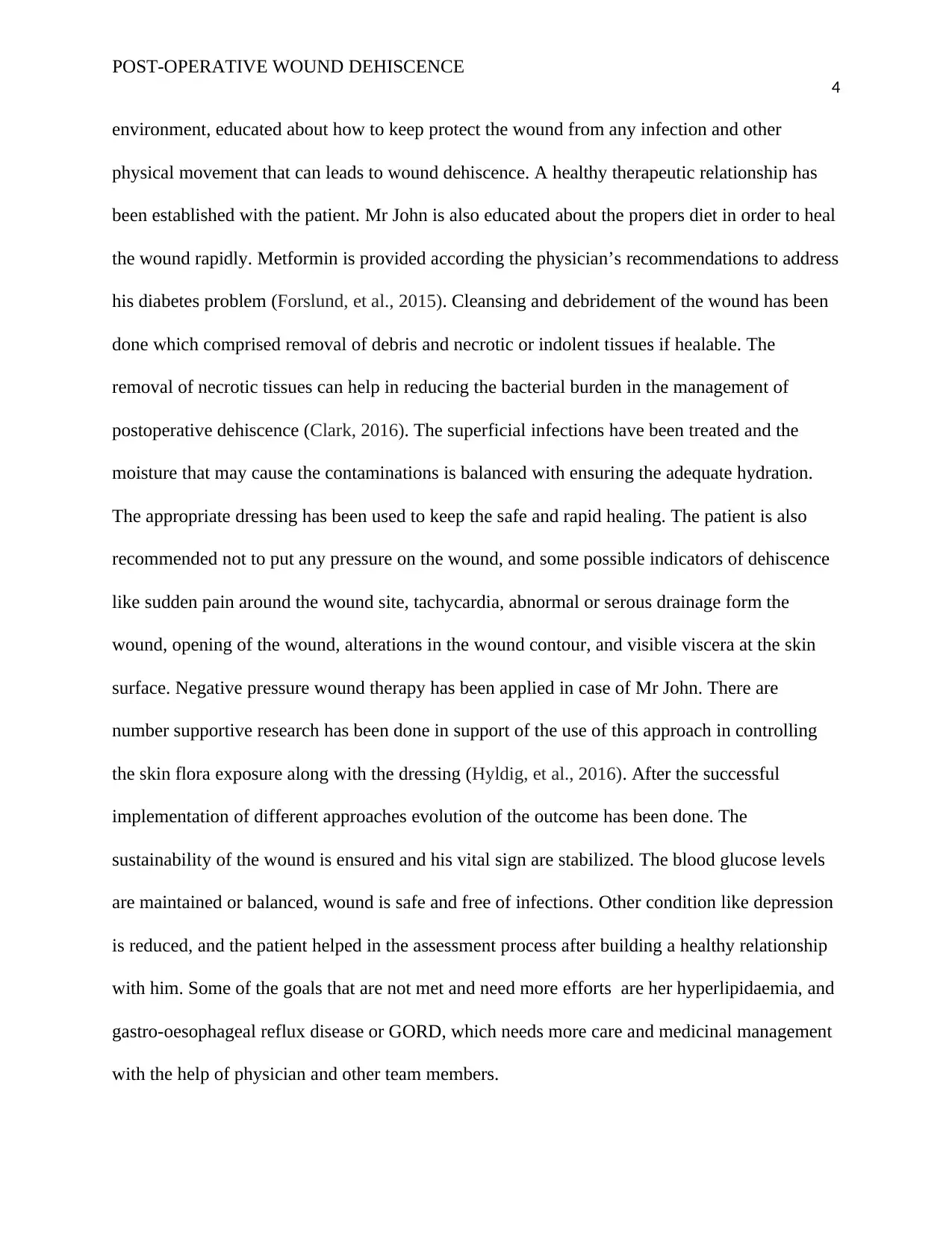
POST-OPERATIVE WOUND DEHISCENCE
4
environment, educated about how to keep protect the wound from any infection and other
physical movement that can leads to wound dehiscence. A healthy therapeutic relationship has
been established with the patient. Mr John is also educated about the propers diet in order to heal
the wound rapidly. Metformin is provided according the physician’s recommendations to address
his diabetes problem (Forslund, et al., 2015). Cleansing and debridement of the wound has been
done which comprised removal of debris and necrotic or indolent tissues if healable. The
removal of necrotic tissues can help in reducing the bacterial burden in the management of
postoperative dehiscence (Clark, 2016). The superficial infections have been treated and the
moisture that may cause the contaminations is balanced with ensuring the adequate hydration.
The appropriate dressing has been used to keep the safe and rapid healing. The patient is also
recommended not to put any pressure on the wound, and some possible indicators of dehiscence
like sudden pain around the wound site, tachycardia, abnormal or serous drainage form the
wound, opening of the wound, alterations in the wound contour, and visible viscera at the skin
surface. Negative pressure wound therapy has been applied in case of Mr John. There are
number supportive research has been done in support of the use of this approach in controlling
the skin flora exposure along with the dressing (Hyldig, et al., 2016). After the successful
implementation of different approaches evolution of the outcome has been done. The
sustainability of the wound is ensured and his vital sign are stabilized. The blood glucose levels
are maintained or balanced, wound is safe and free of infections. Other condition like depression
is reduced, and the patient helped in the assessment process after building a healthy relationship
with him. Some of the goals that are not met and need more efforts are her hyperlipidaemia, and
gastro-oesophageal reflux disease or GORD, which needs more care and medicinal management
with the help of physician and other team members.
4
environment, educated about how to keep protect the wound from any infection and other
physical movement that can leads to wound dehiscence. A healthy therapeutic relationship has
been established with the patient. Mr John is also educated about the propers diet in order to heal
the wound rapidly. Metformin is provided according the physician’s recommendations to address
his diabetes problem (Forslund, et al., 2015). Cleansing and debridement of the wound has been
done which comprised removal of debris and necrotic or indolent tissues if healable. The
removal of necrotic tissues can help in reducing the bacterial burden in the management of
postoperative dehiscence (Clark, 2016). The superficial infections have been treated and the
moisture that may cause the contaminations is balanced with ensuring the adequate hydration.
The appropriate dressing has been used to keep the safe and rapid healing. The patient is also
recommended not to put any pressure on the wound, and some possible indicators of dehiscence
like sudden pain around the wound site, tachycardia, abnormal or serous drainage form the
wound, opening of the wound, alterations in the wound contour, and visible viscera at the skin
surface. Negative pressure wound therapy has been applied in case of Mr John. There are
number supportive research has been done in support of the use of this approach in controlling
the skin flora exposure along with the dressing (Hyldig, et al., 2016). After the successful
implementation of different approaches evolution of the outcome has been done. The
sustainability of the wound is ensured and his vital sign are stabilized. The blood glucose levels
are maintained or balanced, wound is safe and free of infections. Other condition like depression
is reduced, and the patient helped in the assessment process after building a healthy relationship
with him. Some of the goals that are not met and need more efforts are her hyperlipidaemia, and
gastro-oesophageal reflux disease or GORD, which needs more care and medicinal management
with the help of physician and other team members.
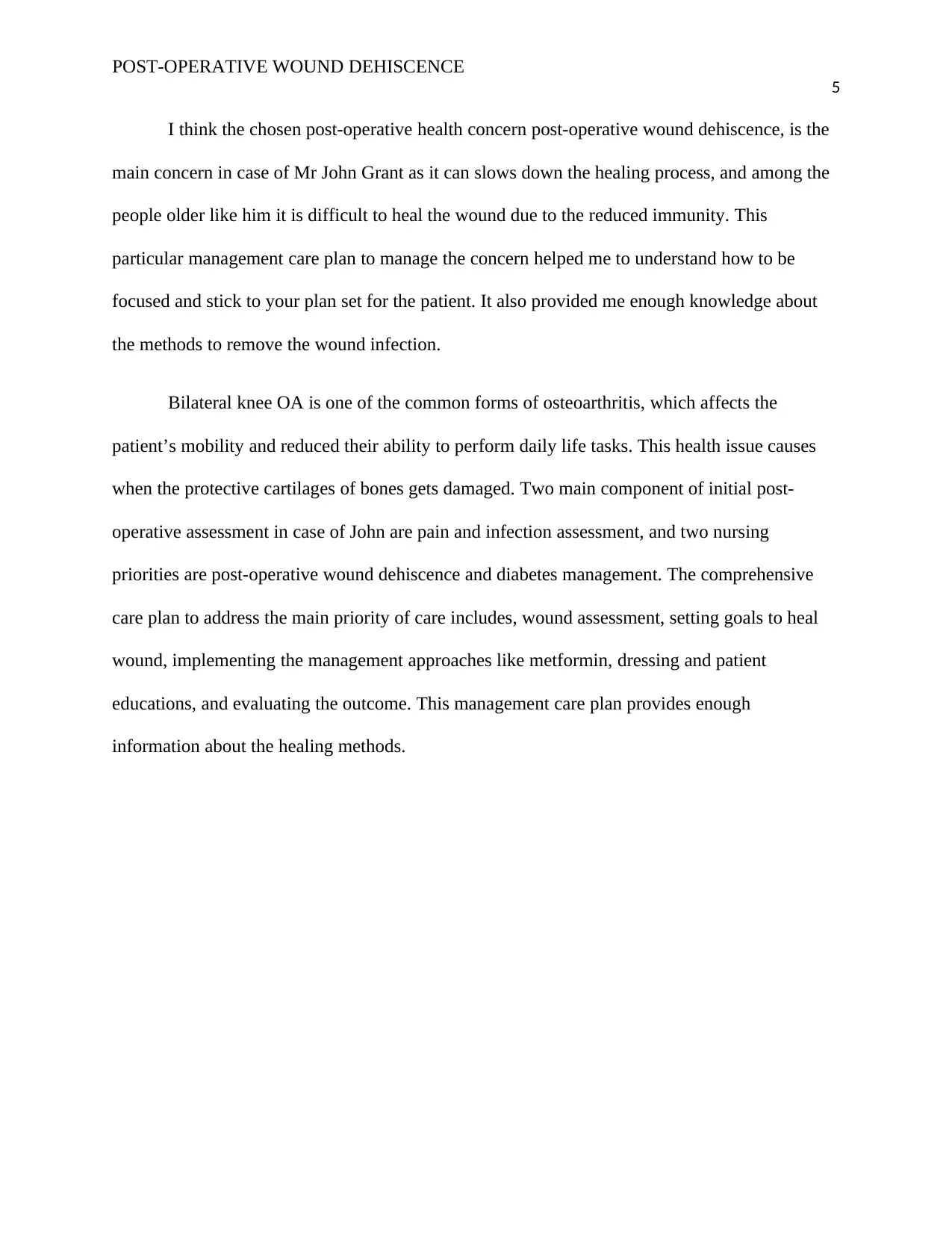
POST-OPERATIVE WOUND DEHISCENCE
5
I think the chosen post-operative health concern post-operative wound dehiscence, is the
main concern in case of Mr John Grant as it can slows down the healing process, and among the
people older like him it is difficult to heal the wound due to the reduced immunity. This
particular management care plan to manage the concern helped me to understand how to be
focused and stick to your plan set for the patient. It also provided me enough knowledge about
the methods to remove the wound infection.
Bilateral knee OA is one of the common forms of osteoarthritis, which affects the
patient’s mobility and reduced their ability to perform daily life tasks. This health issue causes
when the protective cartilages of bones gets damaged. Two main component of initial post-
operative assessment in case of John are pain and infection assessment, and two nursing
priorities are post-operative wound dehiscence and diabetes management. The comprehensive
care plan to address the main priority of care includes, wound assessment, setting goals to heal
wound, implementing the management approaches like metformin, dressing and patient
educations, and evaluating the outcome. This management care plan provides enough
information about the healing methods.
5
I think the chosen post-operative health concern post-operative wound dehiscence, is the
main concern in case of Mr John Grant as it can slows down the healing process, and among the
people older like him it is difficult to heal the wound due to the reduced immunity. This
particular management care plan to manage the concern helped me to understand how to be
focused and stick to your plan set for the patient. It also provided me enough knowledge about
the methods to remove the wound infection.
Bilateral knee OA is one of the common forms of osteoarthritis, which affects the
patient’s mobility and reduced their ability to perform daily life tasks. This health issue causes
when the protective cartilages of bones gets damaged. Two main component of initial post-
operative assessment in case of John are pain and infection assessment, and two nursing
priorities are post-operative wound dehiscence and diabetes management. The comprehensive
care plan to address the main priority of care includes, wound assessment, setting goals to heal
wound, implementing the management approaches like metformin, dressing and patient
educations, and evaluating the outcome. This management care plan provides enough
information about the healing methods.
⊘ This is a preview!⊘
Do you want full access?
Subscribe today to unlock all pages.

Trusted by 1+ million students worldwide
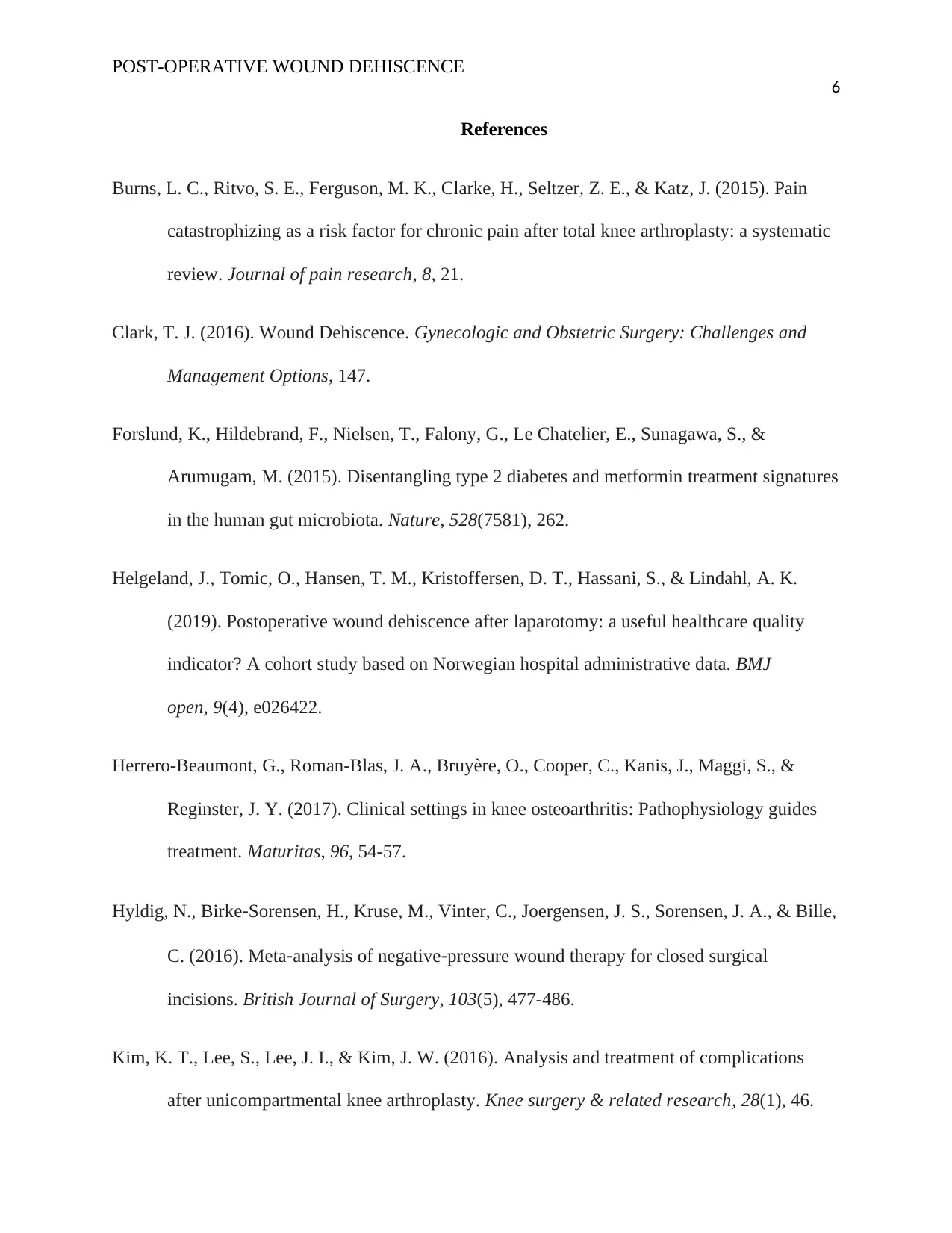
POST-OPERATIVE WOUND DEHISCENCE
6
References
Burns, L. C., Ritvo, S. E., Ferguson, M. K., Clarke, H., Seltzer, Z. E., & Katz, J. (2015). Pain
catastrophizing as a risk factor for chronic pain after total knee arthroplasty: a systematic
review. Journal of pain research, 8, 21.
Clark, T. J. (2016). Wound Dehiscence. Gynecologic and Obstetric Surgery: Challenges and
Management Options, 147.
Forslund, K., Hildebrand, F., Nielsen, T., Falony, G., Le Chatelier, E., Sunagawa, S., &
Arumugam, M. (2015). Disentangling type 2 diabetes and metformin treatment signatures
in the human gut microbiota. Nature, 528(7581), 262.
Helgeland, J., Tomic, O., Hansen, T. M., Kristoffersen, D. T., Hassani, S., & Lindahl, A. K.
(2019). Postoperative wound dehiscence after laparotomy: a useful healthcare quality
indicator? A cohort study based on Norwegian hospital administrative data. BMJ
open, 9(4), e026422.
Herrero-Beaumont, G., Roman-Blas, J. A., Bruyère, O., Cooper, C., Kanis, J., Maggi, S., &
Reginster, J. Y. (2017). Clinical settings in knee osteoarthritis: Pathophysiology guides
treatment. Maturitas, 96, 54-57.
Hyldig, N., Birke‐Sorensen, H., Kruse, M., Vinter, C., Joergensen, J. S., Sorensen, J. A., & Bille,
C. (2016). Meta‐analysis of negative‐pressure wound therapy for closed surgical
incisions. British Journal of Surgery, 103(5), 477-486.
Kim, K. T., Lee, S., Lee, J. I., & Kim, J. W. (2016). Analysis and treatment of complications
after unicompartmental knee arthroplasty. Knee surgery & related research, 28(1), 46.
6
References
Burns, L. C., Ritvo, S. E., Ferguson, M. K., Clarke, H., Seltzer, Z. E., & Katz, J. (2015). Pain
catastrophizing as a risk factor for chronic pain after total knee arthroplasty: a systematic
review. Journal of pain research, 8, 21.
Clark, T. J. (2016). Wound Dehiscence. Gynecologic and Obstetric Surgery: Challenges and
Management Options, 147.
Forslund, K., Hildebrand, F., Nielsen, T., Falony, G., Le Chatelier, E., Sunagawa, S., &
Arumugam, M. (2015). Disentangling type 2 diabetes and metformin treatment signatures
in the human gut microbiota. Nature, 528(7581), 262.
Helgeland, J., Tomic, O., Hansen, T. M., Kristoffersen, D. T., Hassani, S., & Lindahl, A. K.
(2019). Postoperative wound dehiscence after laparotomy: a useful healthcare quality
indicator? A cohort study based on Norwegian hospital administrative data. BMJ
open, 9(4), e026422.
Herrero-Beaumont, G., Roman-Blas, J. A., Bruyère, O., Cooper, C., Kanis, J., Maggi, S., &
Reginster, J. Y. (2017). Clinical settings in knee osteoarthritis: Pathophysiology guides
treatment. Maturitas, 96, 54-57.
Hyldig, N., Birke‐Sorensen, H., Kruse, M., Vinter, C., Joergensen, J. S., Sorensen, J. A., & Bille,
C. (2016). Meta‐analysis of negative‐pressure wound therapy for closed surgical
incisions. British Journal of Surgery, 103(5), 477-486.
Kim, K. T., Lee, S., Lee, J. I., & Kim, J. W. (2016). Analysis and treatment of complications
after unicompartmental knee arthroplasty. Knee surgery & related research, 28(1), 46.
Paraphrase This Document
Need a fresh take? Get an instant paraphrase of this document with our AI Paraphraser
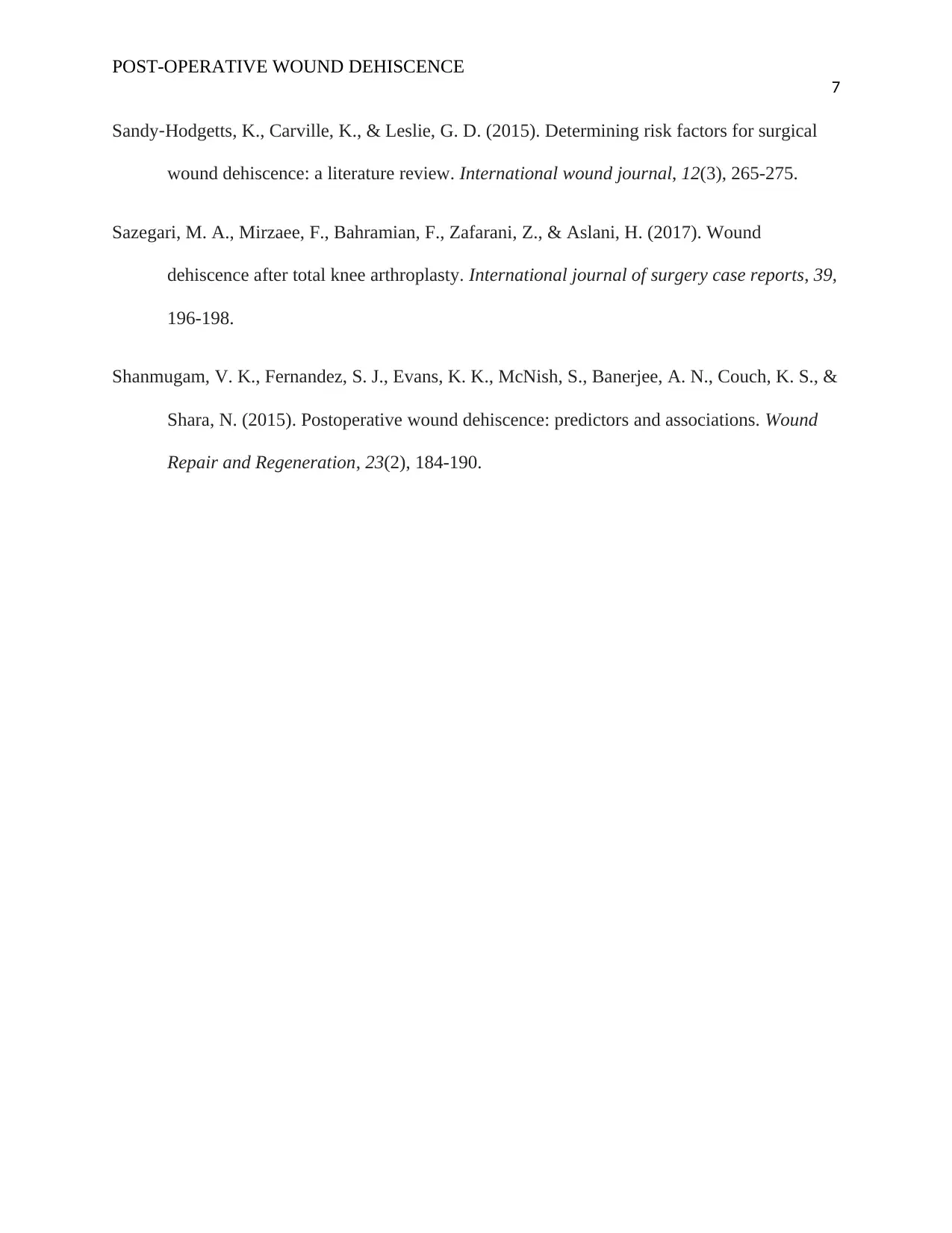
POST-OPERATIVE WOUND DEHISCENCE
7
Sandy‐Hodgetts, K., Carville, K., & Leslie, G. D. (2015). Determining risk factors for surgical
wound dehiscence: a literature review. International wound journal, 12(3), 265-275.
Sazegari, M. A., Mirzaee, F., Bahramian, F., Zafarani, Z., & Aslani, H. (2017). Wound
dehiscence after total knee arthroplasty. International journal of surgery case reports, 39,
196-198.
Shanmugam, V. K., Fernandez, S. J., Evans, K. K., McNish, S., Banerjee, A. N., Couch, K. S., &
Shara, N. (2015). Postoperative wound dehiscence: predictors and associations. Wound
Repair and Regeneration, 23(2), 184-190.
7
Sandy‐Hodgetts, K., Carville, K., & Leslie, G. D. (2015). Determining risk factors for surgical
wound dehiscence: a literature review. International wound journal, 12(3), 265-275.
Sazegari, M. A., Mirzaee, F., Bahramian, F., Zafarani, Z., & Aslani, H. (2017). Wound
dehiscence after total knee arthroplasty. International journal of surgery case reports, 39,
196-198.
Shanmugam, V. K., Fernandez, S. J., Evans, K. K., McNish, S., Banerjee, A. N., Couch, K. S., &
Shara, N. (2015). Postoperative wound dehiscence: predictors and associations. Wound
Repair and Regeneration, 23(2), 184-190.
1 out of 8
Related Documents
Your All-in-One AI-Powered Toolkit for Academic Success.
+13062052269
info@desklib.com
Available 24*7 on WhatsApp / Email
![[object Object]](/_next/static/media/star-bottom.7253800d.svg)
Unlock your academic potential
Copyright © 2020–2025 A2Z Services. All Rights Reserved. Developed and managed by ZUCOL.





